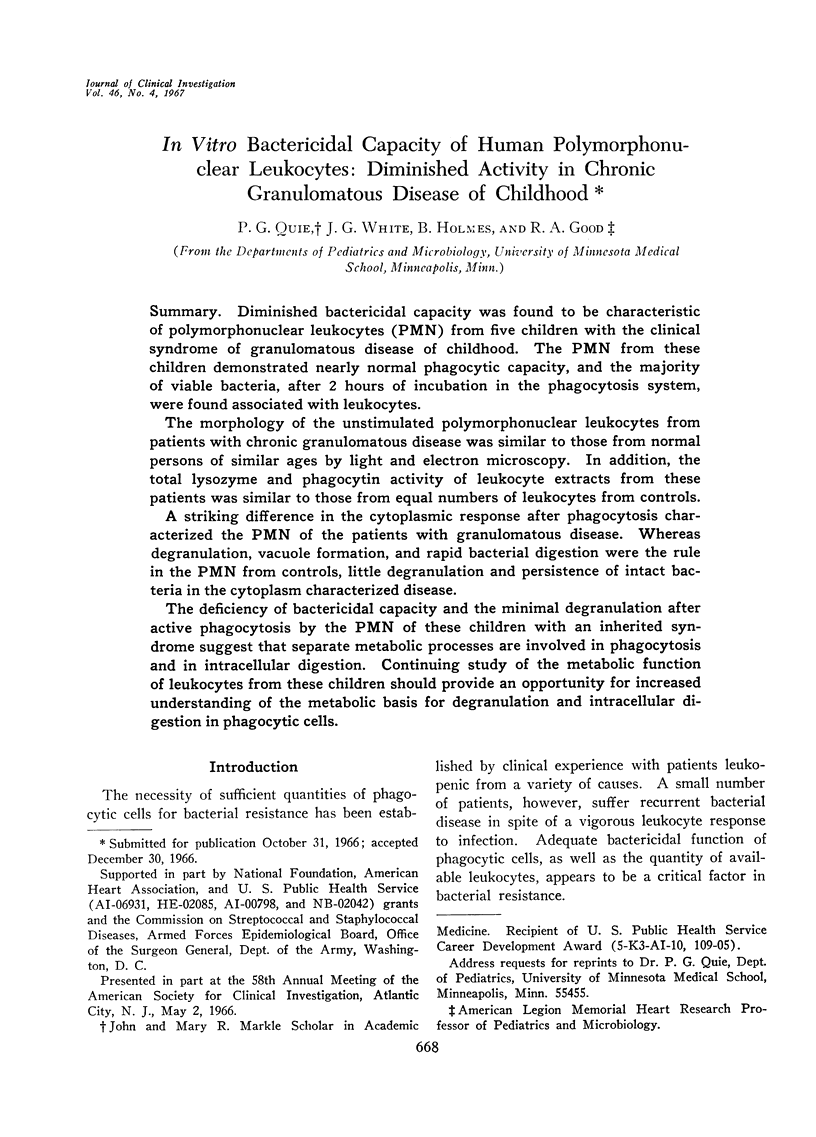Abstract
Diminished bactericidal capacity was found to be characteristic of polymorphonuclear leukocytes (PMN) from five children with the clinical syndrome of granulomatous disease of childhood. The PMN from these children demonstrated nearly normal phagocytic capacity, and the majority of viable bacteria, after 2 hours of incubation in the phagocytosis system, were found associated with leukocytes.
The morphology of the unstimulated polymorphonuclear leukocytes from patients with chronic granulomatous disease was similar to those from normal persons of similar ages by light and electron microscopy. In addition, the total lysozyme and phagocytin activity of leukocyte extracts from these patients was similar to those from equal numbers of leukocytes from controls.
A striking difference in the cytoplasmic response after phagocytosis characterized the PMN of the patients with granulomatous disease. Whereas degranulation, vacuole formation, and rapid bacterial digestion were the rule in the PMN from controls, little degranulation and persistence of intact bacteria in the cytoplasm characterized disease.
The deficiency of bactericidal capacity and the minimal degranulation after active phagocytosis by the PMN of these children with an inherited syndrome suggest that separate metabolic processes are involved in phagocytosis and in intracellular digestion. Continuing study of the metabolic function of leukocytes from these children should provide an opportunity for increased understanding of the metabolic basis for degranulation and intracellular digestion in phagocytic cells.
Full text
PDF











Images in this article
Selected References
These references are in PubMed. This may not be the complete list of references from this article.
- BERENDES H., BRIDGES R. A., GOOD R. A. A fatal granulomatosus of childhood: the clinical study of a new syndrome. Minn Med. 1957 May;40(5):309–312. [PubMed] [Google Scholar]
- BRIDGES R. A., BERENDES H., GOOD R. A. A fatal granulomatous disease of childhood; the clinical, pathological, and laboratory features of a new syndrome. AMA J Dis Child. 1959 Apr;97(4):387–408. [PubMed] [Google Scholar]
- CARSON M. J., CHADWICK D. L., BRUBAKER C. A., CLELAND R. S., LANDING B. H. THIRTEEN BOYS WITH PROGRESSIVE SEPTIC GRANULOMATOSIS. Pediatrics. 1965 Mar;35:405–412. [PubMed] [Google Scholar]
- COHN Z. A., AUSTEN K. F. Contribution of serum and cellular factors in host defense reactions. II. Cellular factors in host resistance. N Engl J Med. 1963 May 9;268:1056–concl. doi: 10.1056/NEJM196305092681906. [DOI] [PubMed] [Google Scholar]
- COHN Z. A., HIRSCH J. G. The influence of phagocytosis on the intracellular distribution of granule-associated components of polymorphonuclear leucocytes. J Exp Med. 1960 Dec 1;112:1015–1022. doi: 10.1084/jem.112.6.1015. [DOI] [PMC free article] [PubMed] [Google Scholar]
- COHN Z. A., HIRSCH J. G. The isolation and properties of the specific cytoplasmic granules of rabbit polymorphonuclear leucocytes. J Exp Med. 1960 Dec 1;112:983–1004. doi: 10.1084/jem.112.6.983. [DOI] [PMC free article] [PubMed] [Google Scholar]
- COHN Z. A., MORSE S. I. Interactions between rabbit polymorphonuclear leucocytes and staphylococci. J Exp Med. 1959 Sep 1;110:419–443. doi: 10.1084/jem.110.3.419. [DOI] [PMC free article] [PubMed] [Google Scholar]
- HIRSCH J. G., CHURCH A. B. Adrenal steroids and infection: the effect of cortisone administration on polymorphonuclear leukocytic functions and on serum opsonins and bactericidins. J Clin Invest. 1961 May;40:794–798. doi: 10.1172/JCI104312. [DOI] [PMC free article] [PubMed] [Google Scholar]
- HIRSCH J. G. Further studies on preparation and properties of phagocytin. J Exp Med. 1960 Mar 1;111:323–337. doi: 10.1084/jem.111.3.323. [DOI] [PMC free article] [PubMed] [Google Scholar]
- HIRSCH J. G., STRAUSS B. STUDIES ON HEAT-LABILE OPSONIN IN RABBIT SERUM. J Immunol. 1964 Jan;92:145–154. [PubMed] [Google Scholar]
- Holmes B., Quie P. G., Windhorst D. B., Good R. A. Fatal granulomatous disease of childhood. An inborn abnormality of phagocytic function. Lancet. 1966 Jun 4;1(7449):1225–1228. doi: 10.1016/s0140-6736(66)90238-8. [DOI] [PubMed] [Google Scholar]
- LANDING B. H., SHIRKEY H. S. A syndrome of recurrent infection and infiltration of viscera by pigmented lipid histiocytes. Pediatrics. 1957 Sep;20(3):431–438. [PubMed] [Google Scholar]
- REBUCK J. W., CROWLEY J. H. A method of studying leukocytic functions in vivo. Ann N Y Acad Sci. 1955 Mar 24;59(5):757–805. doi: 10.1111/j.1749-6632.1955.tb45983.x. [DOI] [PubMed] [Google Scholar]
- SHINEFIELD H. R., RIBBLE J. C., BORIS M., EICHENWALD H. F. Bacterial interference: its effect on nursery-acquired infection with Staphylococcus aureus. I. Preliminary observations on artificial colonzation of newborns. Am J Dis Child. 1963 Jun;105:646–654. [PubMed] [Google Scholar]
- SHUGAR D. The measurement of lysozyme activity and the ultra-violet inactivation of lysozyme. Biochim Biophys Acta. 1952 Mar;8(3):302–309. doi: 10.1016/0006-3002(52)90045-0. [DOI] [PubMed] [Google Scholar]
- White J. G., Krivit W. The ultrastructural localization and release of platelet lipids. Blood. 1966 Feb;27(2):167–186. [PubMed] [Google Scholar]





